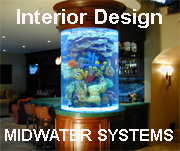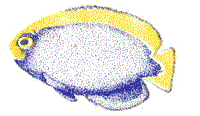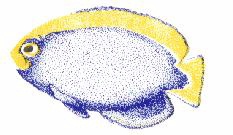|
CRUSTACEANS,
AGGRESSIVE SPECIES (CRABS AND LOBSTERS)
By Jim Wolf Marine Biologist
The division of the Crustaceans into groups of aggressive and passive
species is based on extensive experience on the behavior of different species.
As a general rule most shrimps are passive (mantis shrimps being a notable
exception), while lobsters and crabs are a bit more aggressive.
Technically, both groups are equally aggressive, it is just that the
crabs and lobsters are better equipped with larger claws to do more damage
quicker. These aggressive specimens may attack other crustaceans, small
fish, and other small invertebrates. Avoid exceptionally large specimens,
and watch closely for the first few days for signs of injury.
All crustaceans will do well on a variety of high protein foods such
as frozen shrimp and squid. Many of these animals run the risk of nipping
cniderians. The following list will cover some of the specific concerns
of the different genera.
Panulirus- The Spiny Lobsters. They are not too aggressive, and
will only attack very small (about 1/5 their size) animals so most larger
organisms are safe. They can eat sessile organisms such as barnacles, and
clams. Provide them with a small chunk of food every 2-3 days. If a small
cave is provided for them, they will quickly adopt it as a home.
Enoplometopus- The Reef Lobsters. Their large claws are for defense
and are not often used in gathering food. None the less, they can capture
and eat small animals. Sessile (permanently attached animals) are not at
any risk unless the animal is very hungry. They will eat chunks of frozen
foods, and are best observed at either dawn or dusk.
Stenorhynchus- These are the bizarre Arrow Crabs. They are comparatively
fragile and will not bother anything too big or fast . Small sessile invertebrates
and small shrimps may be attacked, however this is uncommon. If fed well
on standard crab fare, they are quite passive.
Dardanus- The comical Hermit Crabs. These animals have strong
claws that enable them to make a meal of many slow moving or sessile animals.
The do best as a janitor in a tank of larger fishes and hardy larger invertebrates.
Hermits can crawl out of a tank by shimmying up the airline, so secure
the aquarium!
Squilla- The infamous Mantis Shrimps. They possess claws so powerful
that some species can crush your finger with a single blow! A curiosity
best placed into an aquarium designed just for them. They need some sand
to dig in and rocks to hide among. Almost any food is greedy consumed,
and only sessile invertebrates may escape these incredibly voracious animals.
Neopetrolisthes- The unique anemone crabs. They are harmless,
and need an anemone to hide among to avoid being attacked. Liquid invertebrate
foods are sufficient and the crab attains the food by filtering the water
using their specially modified claws.
There are many other species of crustaceans that you might come across.
Take a good look at their pinchers and size, and this will give you some
idea as to their ability to do harm. Consult your fish person for any other
information regarding your specific "decapod friends".
|











